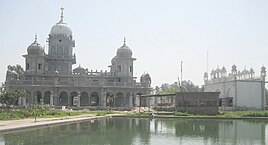
A gurdwara or gurudwara is a place of assembly and worship in Sikhism, but its normal meaning is "place of guru" or "Home of guru". Sikhs also refer to gurdwaras as Gurdwara Sahib. People from all faiths and religions are welcomed in gurdwaras. Each gurdwara has a Darbar Sahib where the Guru Granth Sahib is placed on a takht in a prominent central position. Any congregant may recite, sing, and explain the verses from the Guru Granth Sahib, in the presence of the rest of the congregation.
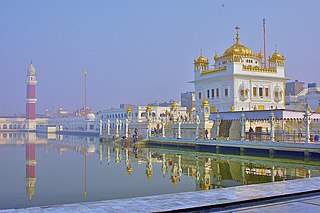
Tarn Taran Sahib is a city in the Majha region of the state of Punjab, in northern India. It is the district headquarters and hosts the municipal council of Tarn Taran district. Gurdwara Sri Tarn Taran Sahib, a prominent Sikh shrine, is located in the central part of the city.
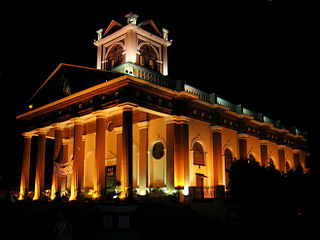
Kapurthala is a city in Punjab state of India. It is the administrative headquarters of Kapurthala District. It was the capital of the Kapurthala State, a princely state in British India. The aesthetic mix of the city with its prominent buildings based on French and Indo-Saracenic architecture self-narrate its princely past. It is also known as city of Palaces & Gardens. According to the 2011 census, Kapurthala is the least populated city in India.

Batala is the eighth largest city in the state of Punjab, India in terms of population after Ludhiana, Amritsar, Jalandhar, Patiala, Bathinda, Mohali and Hoshiarpur. Batala ranks as the second-oldest city after Bathinda. It is a municipal corporation in Gurdaspur district in the Majha region of the state of Punjab. It is located from holy city Amritsar 39 km and about 32km from Gurdaspur, the headquarters of the district. It is also a Police district. Batala holds the status of the most populated town of the district with 31% of the district's total population. It is the biggest industrial town in the district.

Doaba, also known as Bist Doab or the Jalandhar Doab, is the region of Punjab, India that lies between the Beas River and the Sutlej River. People of this region are given the demonym "Doabia". The dialect of Punjabi spoken in Doaba is called "Doabi". The term "Doaba" or "Doab" is derived from Persian دو آب meaning "land of two rivers". The river Sutlej separates Doaba from the Malwa region to its south and the river Beas separates Doaba from the Majha region to its north.

Doraha is a city and a municipal council in Ludhiana district in the state of Punjab, India.
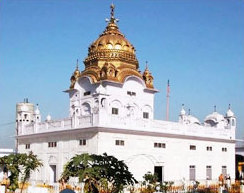
Dera Baba Nanak is a town and a municipal council in Gurdaspur district, in the state of Punjab, India. It is the sub-district headquarters of Dera Baba Nanak tehsil. It is 36 km away from Gurdaspur city, the capital of the district. Since November 2019, a corridor between India and Pakistan has been established at its shrine.

Bhai Mardana was one of the first Sikhs and longtime companion of Guru Nanak Dev, first in the line of gurus noted in Sikhism. Bhai Mardana was a Muslim by-birth who would accompany Guru Nanak Dev on his journeys and became one of his first disciples and followers, and converted to the newly established religion. Bhai Mardana was born to a Mirasi Muslim family, a couple, Badra and Lakkho, of Rai Bhoi di Talwandi, now Nankana Sahib of Pakistan. He was the seventh born, all other children had died at birth. He had very good knowledge of music and played rabāb when Guru Nanak sung Gurbani. Swami Haridas was the disciple of Bhai Mardana and learnt Classical Music from him.
Samana is a town and a municipal council, nearby Patiala City in Patiala district in the Indian state of Punjab.
Urmar Tanda is a town and municipal council in Hoshiarpur district, Punjab, India.

Bebe Nanaki, alternative spelt as Bibi Nanaki, was the elder sister of Guru Nanak, the founder and first Guru of Sikhism. Nanaki is an important figure in Sikhism, and is known as the first Gursikh. She was the first to realize her brother's 'philosophical inclination', and is credited for inspiring his use of music as an instrument of devotion to God.

German Sikhs are a growing religious minority in Germany. The majority of German Sikhs have their roots from the Punjab, India with the remaining coming from the Afghan Sikh community or through conversion. The number of Sikhs is estimated to be between 25,000. Germany had the fifth highest Sikh population in Europe after United Kingdom (524,000), Italy (220,000), Portugal (35,000) and Spain (26,000).

Gurū Nānak, also known as Bābā Nānak, was an Indian spiritual teacher, mystic and poet, who is regarded as the founder of Sikhism and is the first of the ten Sikh Gurus.
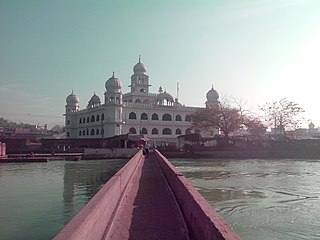
Kiratpur, also known as Kiratpur Sahib, is a town, just 30 km from Rupnagar city in Rupnagar district of Punjab, India. The town is the location of the Gurdwara Patal Puri where many Sikhs take ashes of their deceased.
Saidpur is a village in Sultanpur Lodhi Tehsil, Kapurthala district, Punjab, India, situated in the footsteps of Margalla Hills hardly at five minutes drive from the upscale neighbourhoods of the capital.

Nanakmatta is a historical town named after the Sikh pilgrimage site, Gurdwara Nanak Mata Sahib, also known as Gurdwara Nanakmatta Sahib, in the state of Uttarakhand, India. Sikh tradition records that the site was once called Gorakhmata, a centre of Siddh-jogis named after the founder of their order, Gorakhnath, at the distance of 30 miles from Reetha sahib. In the Siddh-Gost in Guru Granth Sahib, the story of Guru Nanak ji on his first udasi is told, wherein he had a long discourse with siddhas on matters of religion and metaphysics. Tradition says that the place was renamed Nanakmatta to perpetuate the memory of Guru's visit. The town is associated with Guru Nanak Dev and Guru Hargobind.

Kali Bein is a rivulet in Punjab, India that flows into the confluence of the rivers Beas and Satluj at Harike. Guru Nanak attained enlightenment after taking a bath in the Kali Bein, and despite its religious history in Sikhism, the rivulet is not considered holy by the Sikhs in Punjab, as no bodies of water are considered holy in Sikhism aside from the Sikh Sarovars of Gurdwaras. In the wake of the Green Revolution and the rise of chemical pesticides, the Kali Bein became progressively polluted until it was cleaned and rejuvenated in a mass action led by Sant Balbir Singh Seechewal in the 2000s.

Sulakhni (1473–1545), also known as Choni and often referred as Mata Sulakhni, was the wife of Guru Nanak, the founder of Sikhism.
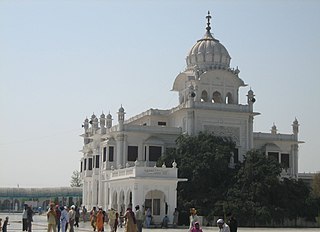
Gurdwara Sri Ber Sahib is a gurdwara in the city of Sultanpur Lodhi, Kapurthala district, Punjab, India, situated on the banks of Kali Bein rivulet. This gurdwara is the historical place related to Guru Nanak Dev Ji, the first Guru of Sikhs.



